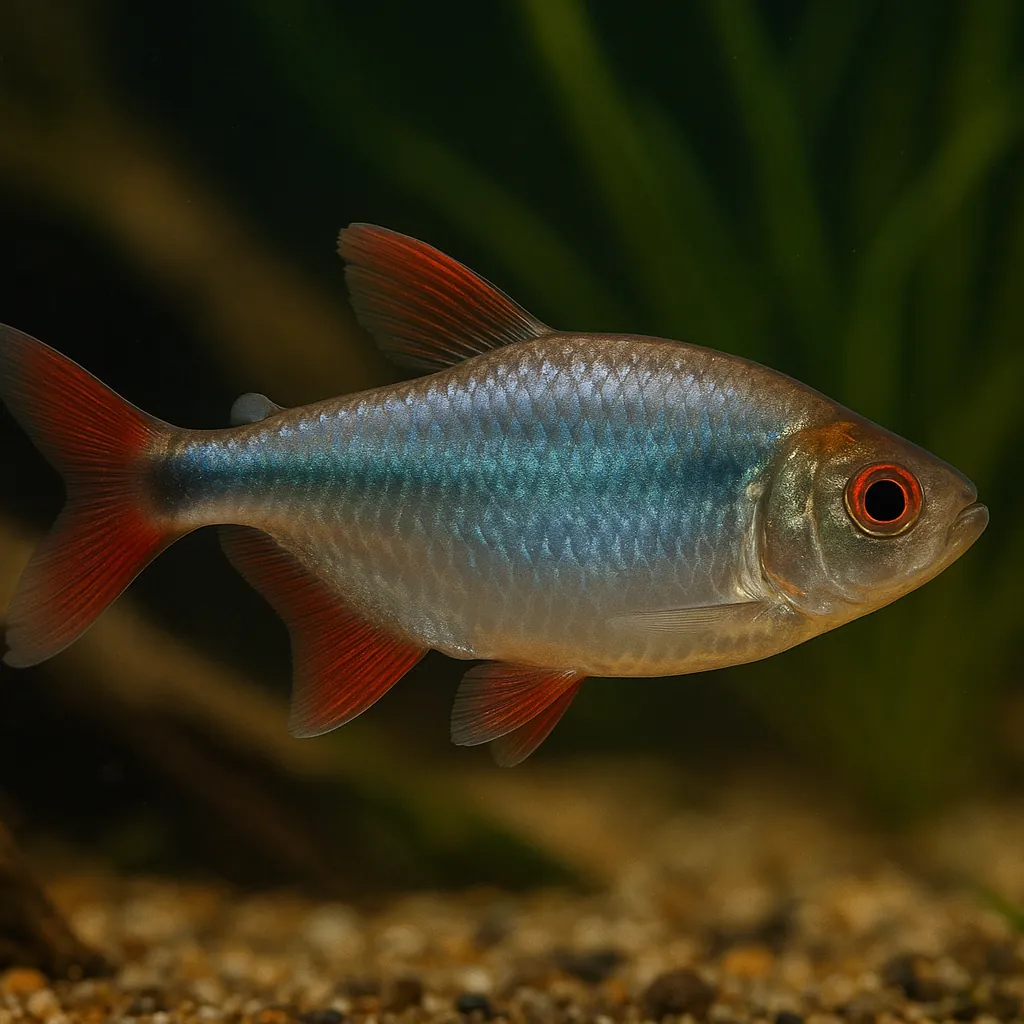
Colombian tetra
Introduction
The Colombian tetra (Hyphessobrycon columbianus), also known as the blue-red Colombian tetra, is a vibrant freshwater fish cherished by aquarists for its striking coloration and active demeanor. With a shimmering silver body accented by a turquoise-blue sheen and vivid red fins, this species adds a splash of color to any aquarium. Its hardy nature and relatively straightforward care requirements make it an excellent choice for both novice and intermediate fishkeepers.
Care and Environment
Providing optimal care for the Colombian tetra involves replicating its natural habitat and meeting its specific needs.
What is the minimum tank size for a Colombian tetra?
A minimum tank size of 75 liters is recommended to accommodate a small group of Colombian tetras, as they are schooling fish that thrive in groups.
What are the ideal water parameters for Colombian tetras?
Maintain water temperatures between 24°C and 27°C, with a pH range of 6.0 to 7.0, and water hardness between 6 to 15 dGH to ensure their well-being.
How should I set up the tank to mimic their natural environment?
Incorporate a soft, sandy substrate with ample live plants like Java fern and Anubias, along with driftwood and rocks to provide hiding spots and replicate their native habitat.
Colombian tetras are omnivorous and accept a variety of foods. A balanced diet should include high-quality flake or pellet food as a staple, supplemented with live or frozen foods such as bloodworms, brine shrimp, and daphnia to enhance their coloration and health.
Regular maintenance is crucial. Perform weekly water changes of 20-25% and ensure efficient filtration to keep the water clean and well-oxygenated. While they are hardy, Colombian tetras can be sensitive to sudden changes in water conditions, so it's essential to monitor parameters consistently.
Origin and Habitat
Colombian tetras are native to the Acandí River in the Chocó Department of northwestern Colombia. They inhabit slow-moving creeks and tributaries characterized by dense vegetation and soft, acidic waters. The natural environment offers warm temperatures, ranging from 24°C to 28°C, with slightly acidic to neutral pH levels. Replicating these conditions in captivity helps ensure their health and longevity.
Temperament and Compatibility
Colombian tetras are active, schooling fish that exhibit peaceful behavior when kept in appropriate conditions.
Are Colombian tetras peaceful community fish?
Yes, they are generally peaceful but can display fin-nipping behavior if not kept in adequate group sizes or if housed with long-finned species.
How many Colombian tetras should be kept together?
It's best to keep them in groups of at least six to eight individuals to promote natural behaviors and reduce stress.
What are suitable tank mates for Colombian tetras?
Compatible tank mates include other similarly sized tetras, rasboras, corydoras catfish, and peaceful dwarf cichlids. Avoid housing them with larger, aggressive fish or species with long, flowing fins to prevent potential aggression or fin-nipping.
Interesting Facts
Colombian tetras were only formally described in 2002, making them a relatively recent addition to the aquarium trade. Despite their recent classification, they have quickly become popular due to their vibrant colors and active nature. In the wild, they are omnivores, feeding on a mix of insects, worms, zooplankton, and plant material. This varied diet contributes to their adaptability in captivity, where they readily accept a range of foods. Breeding Colombian tetras in home aquariums can be challenging, as they are egg scatterers that exhibit no parental care. Providing a separate breeding tank with fine-leaved plants or spawning mops can increase the chances of successful spawning.
Sources
All information in this article has been gathered from the following reputable sources:
Overview
Recommended Tank Size 30.1 Gallons (for groups of 6 or more) |
Minimum Group Size 6 |
Minimum Tank Volume 19.8 Gallons |
Maximum Adult Length 2.6 inches |
Average Adult Length 2 inches |
Shoaling (6+ required) Yes |
Preferred Water Type Freshwater, soft, slightly acidic to neutral |
Temperature Range (°C) 24–27 |
pH Range 6.0–7.0 |
Water Hardness (dGH) 6–15 |
Typical Lifespan (years) 3 years |